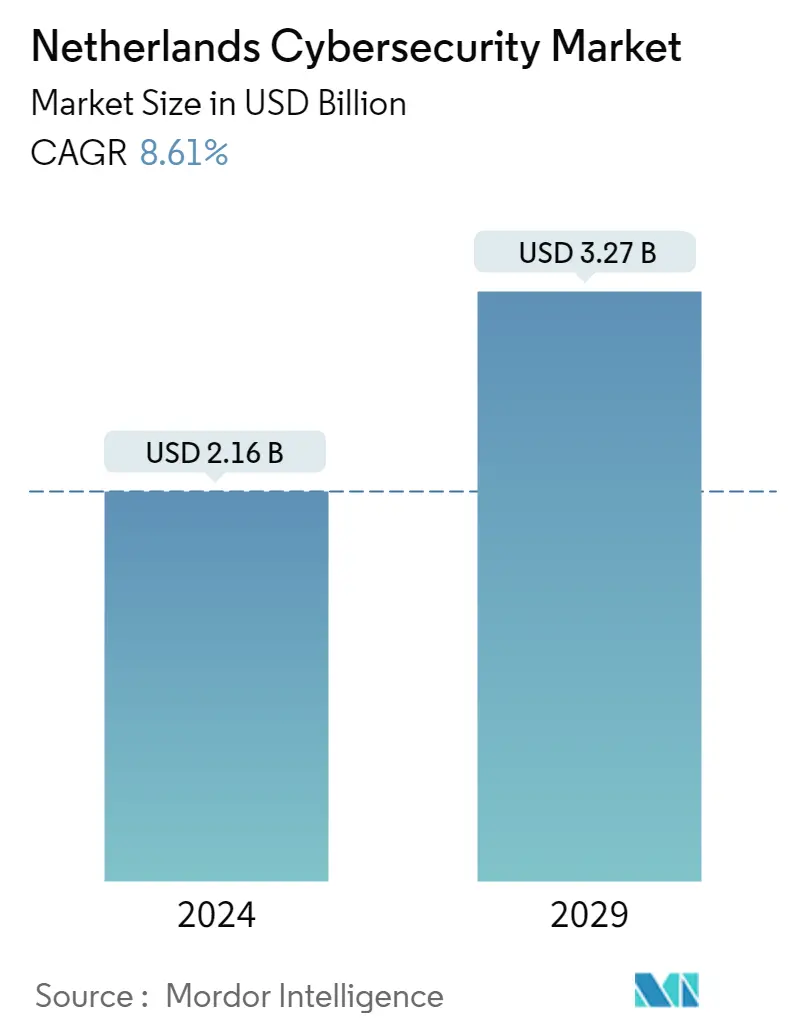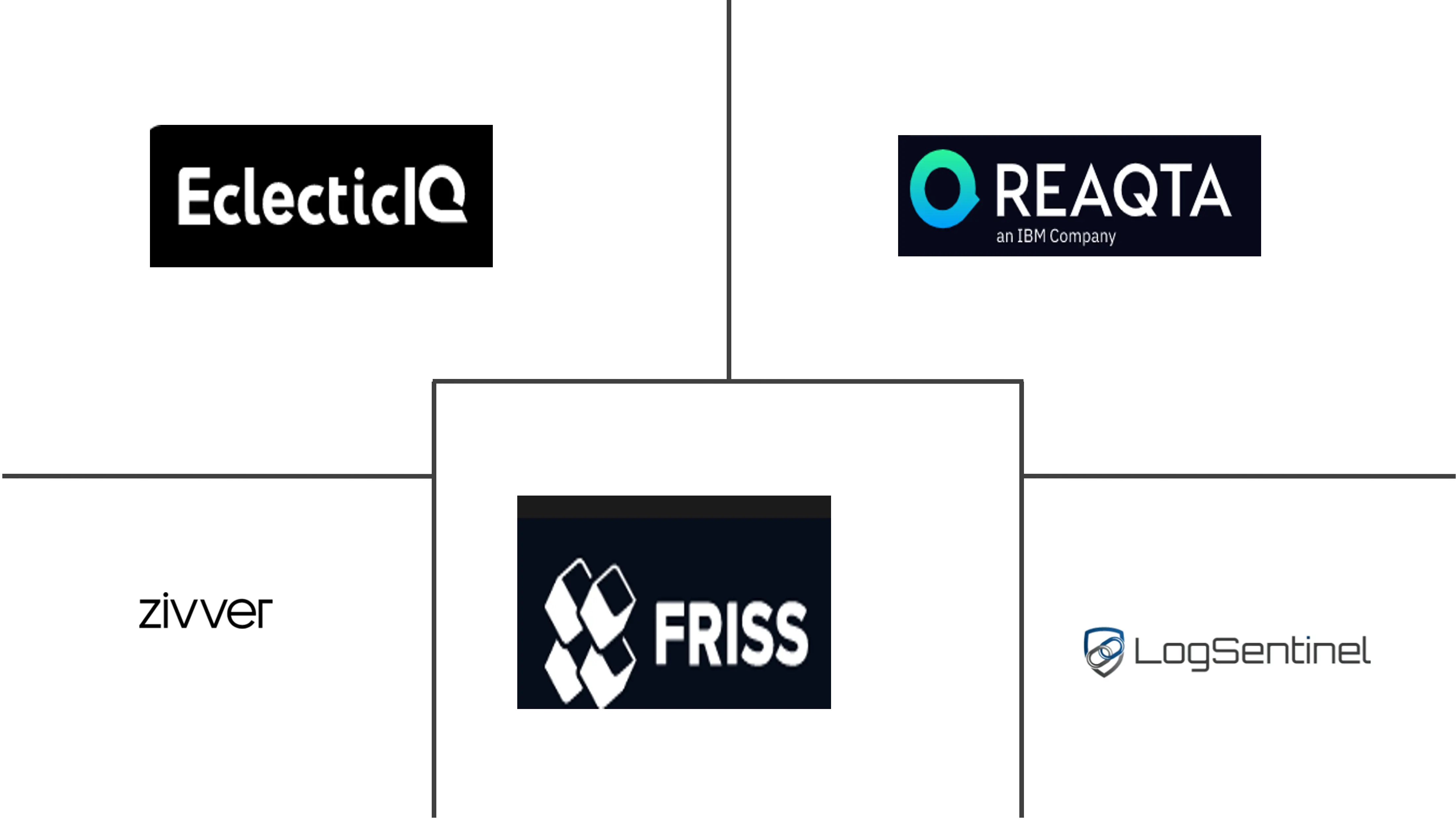Market Size of Netherlands Cybersecurity Industry

| Study Period | 2019 - 2029 |
| Base Year For Estimation | 2023 |
| Market Size (2024) | USD 2.16 Billion |
| Market Size (2029) | USD 3.27 Billion |
| CAGR (2024 - 2029) | 8.61 % |
| Market Concentration | High |
Major Players
*Disclaimer: Major Players sorted in no particular order |
Netherlands Cybersecurity Market Analysis
The Netherlands Cybersecurity Market size is estimated at USD 2.16 billion in 2024, and is expected to reach USD 3.27 billion by 2029, growing at a CAGR of 8.61% during the forecast period (2024-2029).
The Netherlands is also known as the digital gateway to Europe and is one of the world's most wired countries. The country has consistently ranked top in the annual DHL Global Connectedness Index. The Netherlands' internet economy is estimated to account for more than 6% of the country's GDP and is expected to expand further in the coming years. Almost all households have a broadband connection. Nearly one-third of Europe's data centers are located in the Amsterdam region. As a result, cybercrime, digital espionage, and online service disruption are major concerns.
- The Hague region has established itself as a cybersecurity hub over the last decade. The Dutch government recently launched the Global Forum for Cyber Expertise in The Hague, where Europol's European Cyber Crime Center (EC3) and NATO's Communications and Information Agency are already housed. It also serves as the home of The Hague Security Delta, Europe's largest security cluster, which brings together (cyber) security firms, government agencies, and knowledge institutions. With a thriving startup ecosystem, the Netherlands is emerging as a European leader in FinTech, AgTech, and technology-based mobility solutions.
- Despite positive developments in cyber security, various incidents in the past year have demonstrated that the Netherlands still has a lot of work to do, according to a National Coordinator for Counterterrorism and Security report.
- Opportunities in the Netherlands are comparable to those in the United States and other advanced and digitally advanced countries. The Dutch are among the first to adopt new technologies. US cybersecurity firms typically establish themselves in the United Kingdom before expanding into the Dutch market and the rest of Europe.
- The COVID - 19 Pandemic has caused significant changes in many industries, the most notable of which is the information technology (IT) industry. Increased digitalization across sectors and work from home has increased cyberattacks, driving up demand for cybersecurity in the Netherlands market. The COVID-19 pandemic accelerated digitization as businesses closed and millions of Dutch people were forced to work from home, away from the secure networks of their usual workplaces. The situation has heightened cybersecurity threats.
- In the past, companies have mainly invested in ICT infrastructure to make working from home possible. 48% of the respondents indicate that that has been the most important investment, as it turns out from the investigation. A comparable group of respondents suggests that no ICT investments are made to facilitate working from home. The COVID-19 outbreak has changed this: now, 65% say there are ICT investments that have been created.
Netherlands Cybersecurity Industry Segmentation
Cybersecurity solutions help organizations detect, monitor, report, and counter cyber threats to maintain data confidentiality. The adoption of cybersecurity solutions is expected to grow in line with the rising internet penetration among developing and developed countries. The need for cybersecurity has increased as every system in today's world is connected to the internet, making data more accessible to cybercriminals.
The cybersecurity market is segmented by product type (solutions (application security, cloud security, consumer security software, data security, identity and access management, infrastructure protection, integrated risk management, network security equipment, and other solutions) and services (professional and managed)), deployment (on-premise and cloud), end-user industry (BFSI, healthcare, aerospace and defense, IT and telecommunication, government, retail, and manufacturing), and geography.
| By Offering (Trend Analysis with coverage on number of users) | |||||||||
| |||||||||
| Services |
| By Deployment | |
| Cloud | |
| On-premise |
| By End User | |
| BFSI | |
| Healthcare | |
| Manufacturing | |
| Government & Defense | |
| IT and Telecommunication | |
| Other End Users |
Netherlands Cybersecurity Market Size Summary
The Netherlands cybersecurity market is poised for significant growth, driven by its status as a digital gateway to Europe and its highly connected infrastructure. With a robust internet economy and a substantial presence of data centers, particularly in the Amsterdam region, the country faces increasing challenges from cybercrime and digital threats. The Hague has emerged as a key cybersecurity hub, hosting major international organizations and security clusters that foster collaboration between government, industry, and academia. Despite the advancements, the Netherlands continues to address cybersecurity vulnerabilities, with opportunities for growth comparable to those in other advanced digital economies. The COVID-19 pandemic has further accelerated the demand for cybersecurity solutions, as increased remote work and digitalization have heightened the risk of cyberattacks.
The Dutch market is characterized by a strong adoption of cloud computing and innovative IT solutions, positioning it as a leader in the European Union. The shift towards cloud-based business models has been significant, with a notable increase in the use of Software as a Service (SaaS) applications across various sectors. The market is also witnessing a surge in the adoption of multifactor authentication and other security measures to enhance organizational resilience. The government's proactive approach in seeking innovative cybersecurity solutions and fostering long-term collaborations underscores its commitment to strengthening the country's digital security framework. As the Netherlands continues to develop its cybersecurity capabilities, it remains a vibrant ecosystem for technological innovation and collaboration, attracting both domestic and international players in the industry.
Netherlands Cybersecurity Market Size - Table of Contents
-
1. MARKET INSIGHTS
-
1.1 Market Overview
-
1.2 Industry Value Chain Analysis
-
1.3 Industry Attractiveness - Porter's Five Forces Analysis
-
1.3.1 Bargaining Power of Suppliers
-
1.3.2 Bargaining Power of Consumers
-
1.3.3 Threat of New Entrants
-
1.3.4 Intensity of Competitive Rivalry
-
1.3.5 Threat of Substitutes
-
-
1.4 Assessment of COVID-19 Impact on the Market
-
-
2. MARKET SEGMENTATION
-
2.1 By Offering (Trend Analysis with coverage on number of users)
-
2.1.1 Security Type
-
2.1.1.1 Cloud Security
-
2.1.1.2 Data Security
-
2.1.1.3 Identity Access Management
-
2.1.1.4 Network Security
-
2.1.1.5 Consumer Security
-
2.1.1.6 Infrastructure Protection
-
2.1.1.7 Other Types
-
-
2.1.2 Services
-
-
2.2 By Deployment
-
2.2.1 Cloud
-
2.2.2 On-premise
-
-
2.3 By End User
-
2.3.1 BFSI
-
2.3.2 Healthcare
-
2.3.3 Manufacturing
-
2.3.4 Government & Defense
-
2.3.5 IT and Telecommunication
-
2.3.6 Other End Users
-
-
Netherlands Cybersecurity Market Size FAQs
How big is the Netherlands Cybersecurity Market?
The Netherlands Cybersecurity Market size is expected to reach USD 2.16 billion in 2024 and grow at a CAGR of 8.61% to reach USD 3.27 billion by 2029.
What is the current Netherlands Cybersecurity Market size?
In 2024, the Netherlands Cybersecurity Market size is expected to reach USD 2.16 billion.

